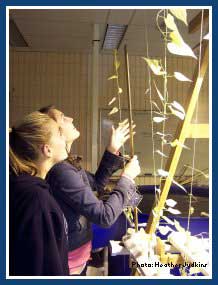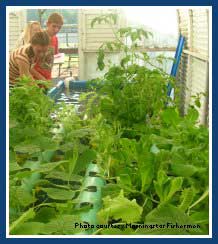
Students at Seminole High School were amazed at how quickly plants grew in their aquaponic system. |
A left-over grow light and hydroponics system in the chemistry lab Ų part of another class experiment Ų inspired them to create an „aquaponicsš lab, a dual system where vegetables thrive in nutrients that would otherwise harm sealife.
„My class and I talked it out and brainstormed on how to reduce the ammonia while not harming the stock and we came across some information on adding the hydroponics unit,š she said. „We reduced changing the water from approximately 250 gallons every two weeks to 250 gallons every five or six weeks Ų the plants were soaking up the nitrogen.š
And although mechanical problems with pumps limited the growth of vegetables in the Seminole High lab, Pasco Middle School students reaped a bountiful harvest of lettuce, tomatoes, cucumbers and herbs in an aquaponic system donated to them by Morningstar Fishermen in Dade City.
„From an agricultural perspective the vegetables are as valuable as the fish,š notes Ric Roberts, Pasco agriscience teacher. „The plants just filled the greenhouse Ų it really surprised me that they did as well as they did.š
Wave of the Future
Around the world, the single most important challenge facing aquaculture operators is fish waste, which typically contains high levels of nutrients, notes Gordon Creaser, an international aquaponics consultant based in Crestview, Fla. While necessary for life, excess nutrients damage underwater ecosystems by encouraging algal blooms that block sunlight and consume oxygen. If those nutrients are captured and used on land, however, they can provide a balanced fertilizer for healthy organic vegetables.

A simple aquaponics setup at Pasco Middle School produced an amazing amount of vegetables, fruits and herbs. |
„We need to teach people that those nutrients are a very valuable commodity and that they can be captured in a simple aquaponic system,š Creaser said. „Aquaponics is the wave of the future.š
Since building his first commercial hydroponic system in 1953, Creaser‚s clients have ranged from commercial growers with more than 600 acres of greenhouse facilities to smaller subsistence farms in impoverished nations. Among his most recent clients is Raffles, a new resort in the Grenadines that includes the Trump Island Villas, a Trump-run casino and Trump International Golf Course.
„The system allows them to have fresh fish and vegetables available yearround,š Creaser said. „It‚s an extremely expensive resort and their clientele demands absolutely fresh and beautiful produce. If they have to bring their vegetables in, even by air freight, they‚re not going to get the same quality they do growing them there.š
While not all of Creaser‚s hydroponic clients are set up for aquaculture, the systems that include fish are now set up so that all nutrients are captured. „You can build them to have zero waste, and even go back in and retrofit older aquaculture systems to capture the nutrients.š
In sophisticated systems where optimum growth is important, water is carefully monitored for ammonia, pH and electrical conductivity (EC), but aquaponics is much like gardening, he said. „One of the reasons I‚ve been so successful is that we keep it as simple as possible. EC might be perfect at about 2000 but it could go down to 1800 or up to 2500 without really hurting anything.š
Victory Garden for the New Millennium
To Hans Geissler, founder of the non-profit Morningstar Fishermen in Dade City, aquaponics is the „victory garden of the new millennium,š providing hundreds of pounds of fish and fresh vegetables for hungry families in poor nations as well as healthy food for suburbanites concerned about high levels of pesticides in the foods they purchase.
„Using fish byproducts actually lets you harvest more pounds of lettuce, tomatoes and other vegetables than fish,š he says.

Students at Seminole High carefully measure fish and track their weight. |
Geissler has transformed an 11-acre tropical fish farm outside Dade City into an international hub for aquaponics students who come to Florida as part of programs offered through Hillsborough Community College and St. Leo University. They learn how to operate the systems and take that knowledge back to countries like Haiti, Dominican Republic and Guatemala where they work with local groups to create community aquaponics systems.
„We teach them how to build and operate everything from a small farm to a backyard system that feeds an extended family,š he said. A member of Rotary International, Geissler helps students raise funds in the U.S. for larger systems. Once they‚re back in their own country, local Rotarians provide ongoing support and accountability for operations that provide jobs and food in regions where both are scarce.
Formerly a soldier in the French Foreign Legion, a successful plumbing contractor and an award-winning boat builder, Geissler became a fish farmer after a mission to Guatemala. „I saw poverty and hunger first hand, and God showed me how I could help.š
Like Creaser, some of the systems Geissler‚s students build are large enough to feed entire communities, but many are small and designed for subsistence farming. One of the more recent accomplishments is a system powered by a solar bilge pump. „You can dig the pond by hand and line it with a plastic tarp,š he said. „This is not rocket science.š
|